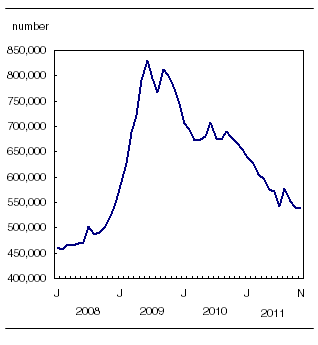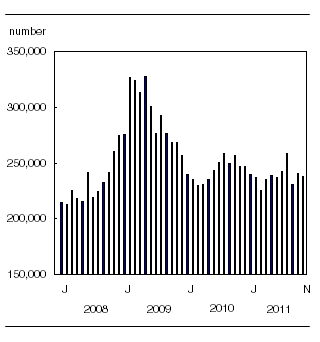Employment Insurance
Archived Content
Information identified as archived is provided for reference, research or recordkeeping purposes. It is not subject to the Government of Canada Web Standards and has not been altered or updated since it was archived. Please "contact us" to request a format other than those available.
Related subjects
-
[an error occurred while processing this directive]
In November, the number of people receiving regular Employment Insurance (EI) benefits totalled 539,000, virtually unchanged from the previous month.
The number of EI beneficiaries fell in Prince Edward Island, Ontario, Nova Scotia and Newfoundland and Labrador. In British Columbia and Quebec, the number of people receiving benefits rose slightly.
Number of Employment Insurance beneficiaries virtually unchanged in November

Chart description: Number of Employment Insurance beneficiaries virtually unchanged in November
Note to readers
The change in the number of regular Employment Insurance (EI) beneficiaries reflects various situations, including people becoming beneficiaries, people going back to work, and people exhausting their regular benefits.
All data in this release are seasonally adjusted unless otherwise specified.
EI statistics are produced from administrative data sources provided by Service Canada and Human Resources and Skills Development Canada. These statistics may, from time to time, be affected by changes to the Employment Insurance Act or administrative procedures. The number of regular beneficiaries and the number of claims received for October and November are preliminary. In this release, large centres correspond to those with a population of 10,000 or more.
The number of beneficiaries is a measure of all people who received EI benefits from November 6 to 12. This period coincides with the reference week of the Labour Force Survey (LFS).
EI statistics indicate the number of people who received EI benefits, and should not be confused with data coming from the LFS, which provides information on the total number of unemployed people.
There is always a certain proportion of unemployed people who do not qualify for benefits. Some unemployed people have not contributed to the program because they have not worked in the past 12 months or their employment is not insured. Other unemployed people have contributed to the program but do not meet the eligibility criteria, such as workers who left their job voluntarily or those who did not accumulate enough hours of work to receive benefits.
Claims down slightly in November
To receive EI benefits, individuals must first submit a claim. The number of claims provides an indication of the number of people who could become beneficiaries.
Nationally, the number of initial and renewal claims edged down 0.8% to 238,300 in November. While claims fell 4.2% in Ontario, they increased 5.7% in Manitoba and 5.0% in Saskatchewan. There was little or no change in the other provinces.
Number of claims slightly down in November

Chart description: Number of claims slightly down in November
Number of beneficiaries down in four provinces
Provincially, the number of people receiving regular EI benefits in November declined in Prince Edward Island (-2.7%), Ontario (-1.8%), Nova Scotia (-1.6%) and Newfoundland and Labrador (-1.6%). The number edged up in British Columbia (+1.2%) and Quebec (+0.7%), while it was little changed in the other provinces.
The decrease in Ontario continued a two-year-long series of declines. In Nova Scotia, the number of beneficiaries declined for the third consecutive month.
While virtually unchanged in November, the number of EI beneficiaries in Alberta has been on a steady downward trend since October 2009.
Sub-provincial and demographic overview
EI data by sub-provincial region, sex and age are not seasonally adjusted and are therefore compared on a year-over-year basis.
Most large centres continue to post declines
Between November 2010 and November 2011, the number of people receiving regular benefits fell 108,200 (-18.8%) nationally. Declines occurred in 133 of the 143 large centres (see map). Large centres are those with a population of 10,000 or more.
In Newfoundland and Labrador, the number of beneficiaries decreased in four of the five large centres. In St. John's, the number fell 15.6%, continuing a series of declines that began 20 months earlier.
In Prince Edward Island, both large centres had fewer beneficiaries in November, with the biggest percentage decline in Summerside. In Charlottetown, the number of people receiving benefits fell 10.2%.
In Nova Scotia, all five large centres had fewer beneficiaries in November compared with November 2010, with the largest percentage decrease in Kentville. In Halifax, the number of beneficiaries fell 16.7% to 4,400, continuing the downward trend that began in spring 2010.
In New Brunswick, three of the six large centres had fewer beneficiaries in November compared with 12 months earlier. The number of people receiving benefits fell 14.3% in Saint John and 14.1% in Moncton.
In Quebec, the number of beneficiaries declined in 31 of the 33 large centres, with the largest percentage decreases in Rouyn-Noranda and Saint-Hyacinthe. In the census metropolitan area of Québec, the number decreased 23.1%. In Montréal, the number of people receiving benefits fell 22.0% to 45,400, continuing the downward trend that began in spring 2010. There were also marked year-over-year declines in Saint-Jean-sur-Richelieu, Granby and Gatineau.
In Ontario, 38 of the 41 large centres had fewer beneficiaries in November compared with 12 months earlier. The largest percentage decreases occurred in Tillsonburg, Stratford, Hamilton, Thunder Bay, Chatham-Kent and Guelph. In Toronto, the number of beneficiaries fell 28.6% to 49,100, extending a downward trend going back to spring 2010.
In Manitoba, the number of people receiving regular benefits declined in all four large centres in the 12 months to November. In Winnipeg, the number of beneficiaries fell 24.8% to 4,900, the 15th consecutive month of year-over-year declines.
In Saskatchewan, all eight large centres recorded monthly year-over-year declines, the largest occurring in Regina and Saskatoon. In Regina, the number of beneficiaries fell 35.2% to 800, continuing the downward trend that began in summer 2010. In Saskatoon, 1,300 people received benefits, down 26.9%, the 12th consecutive year-over-year monthly decline.
In Alberta, 11 of the 12 large centres had fewer beneficiaries in the 12 months to November. The largest percentage decreases occurred in Grande Prairie, Calgary, Cold Lake, Red Deer, Lethbridge and Edmonton. In Calgary, the number of people receiving benefits fell 41.7% to 6,900, while in Edmonton, it declined 37.7% to 7,700.
In British Columbia, the number of beneficiaries fell in all 25 large centres, with the largest percentage declines in Fort St. John, Powell River, Terrace, Kamloops and Vernon. In Vancouver, 22,100 people received benefits in November, down 28.7% from 12 months earlier. In Victoria, the number of beneficiaries totalled 2,700, down 21.7%.
Demographic groups
The number of men receiving regular benefits fell 19.9% to 268,700 between November 2010 and November 2011. The pace of decline was similar for men under 25 years of age (-20.1%) and those aged 25 to 54 (-20.9%). Among men aged 55 and over, the number of beneficiaries fell 16.7%.
A total of 198,700 women received benefits in November, down 17.3% from November 2010. Among those under 25, the number of beneficiaries fell 21.0%, while for those aged 25 to 54, it was down 18.0%. For women aged 55 and over, the number of beneficiaries declined 13.5%.
Available on CANSIM: tables 276-0001 to 276-0004, 276-0006, 276-0009 and 276-0011.
Definitions, data sources and methods: survey number 2604.
Data tables are also now available online. From the Key resource module of our website, under Summary tables, choose Subject then Labour.
Data on Employment Insurance (EI) for December will be released on February 17.
A set of maps, Employment Insurance Statistics Maps, November 2011 (73-002-X, free), is now available online. The maps show percent changes in the number of people receiving regular EI benefits for all census metropolitan areas and census agglomerations in Canada. From the Key resource module of our website, under Publications, choose All subjects, then Labour.
For more information, contact Statistics Canada's National Contact Centre (toll-free 1-800-263-1136; 613-951-8116; infostats@statcan.gc.ca), Communications Division.
To enquire about the concepts, methods or data quality of this release, contact Lahouaria Yssaad (613-951-0627), Labour Statistics Division.
- Date modified:
